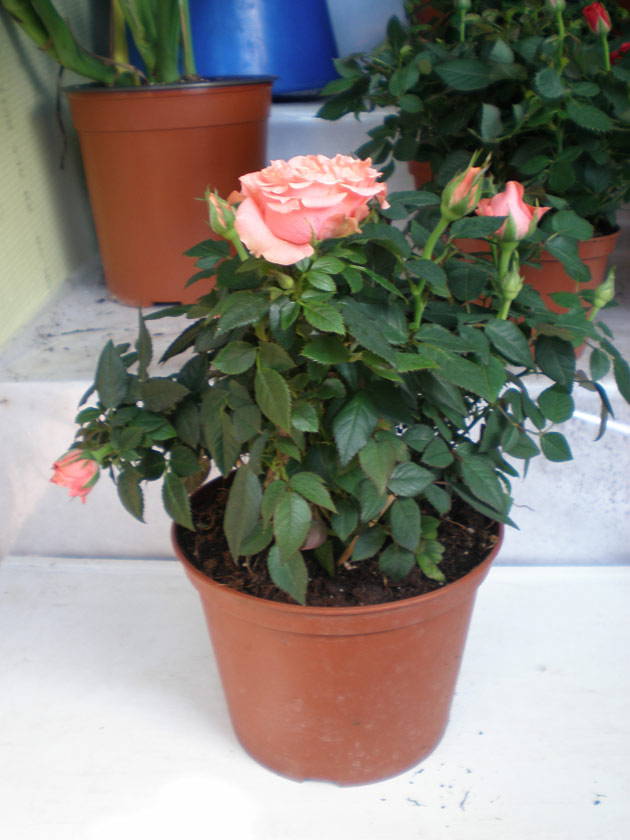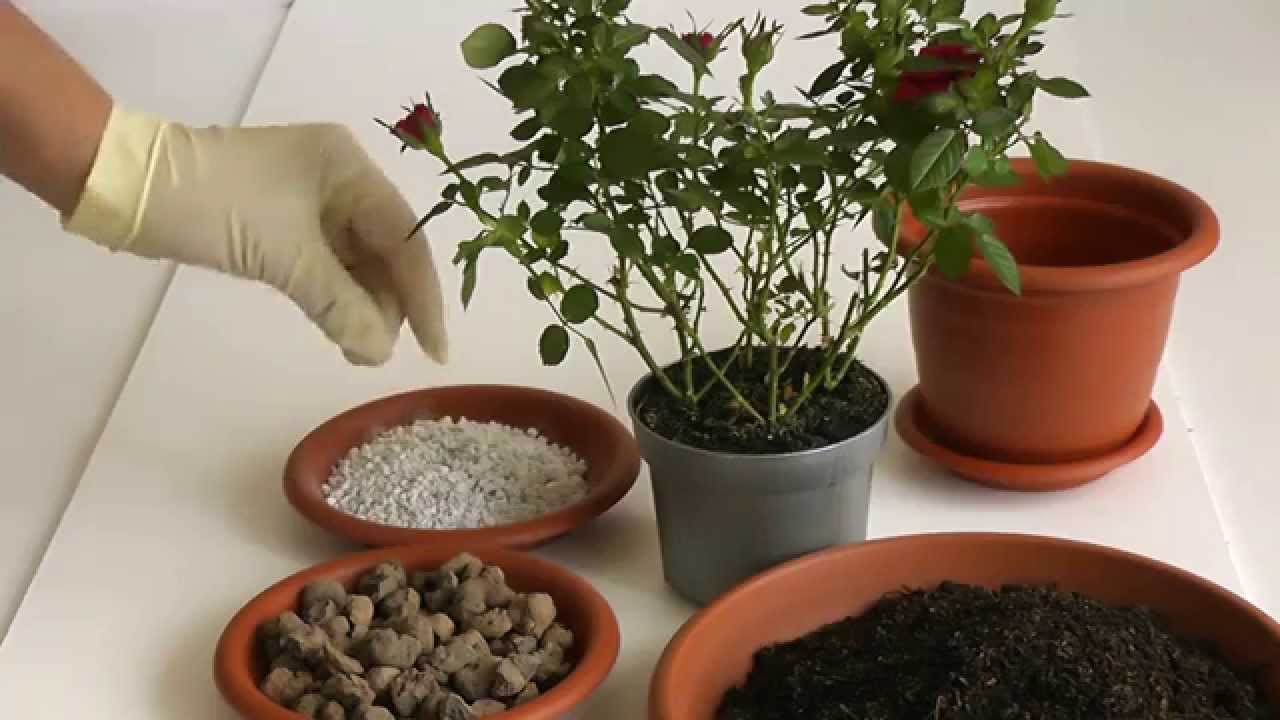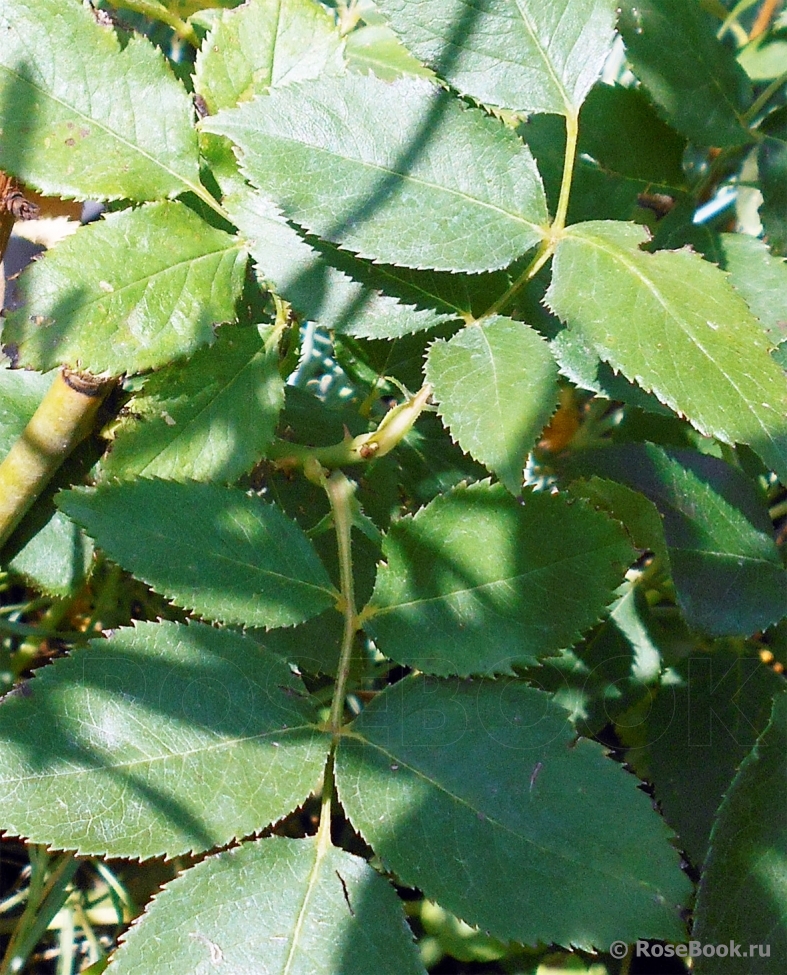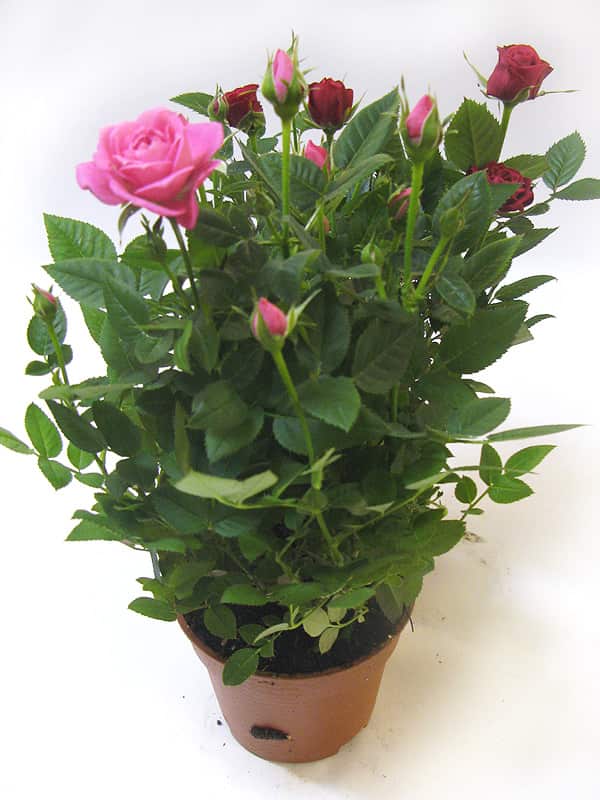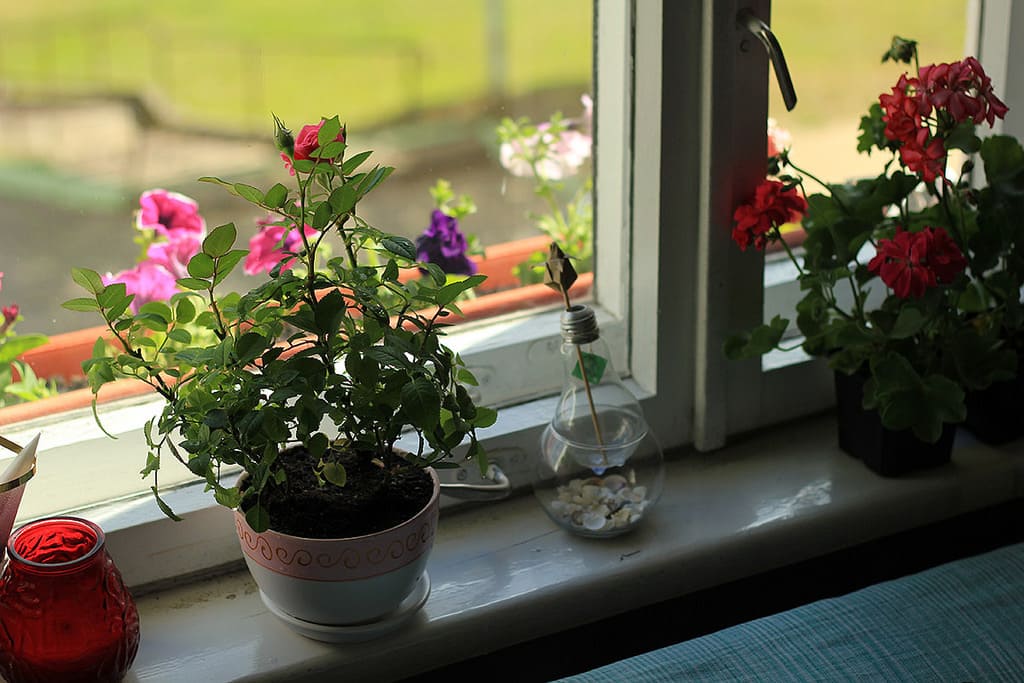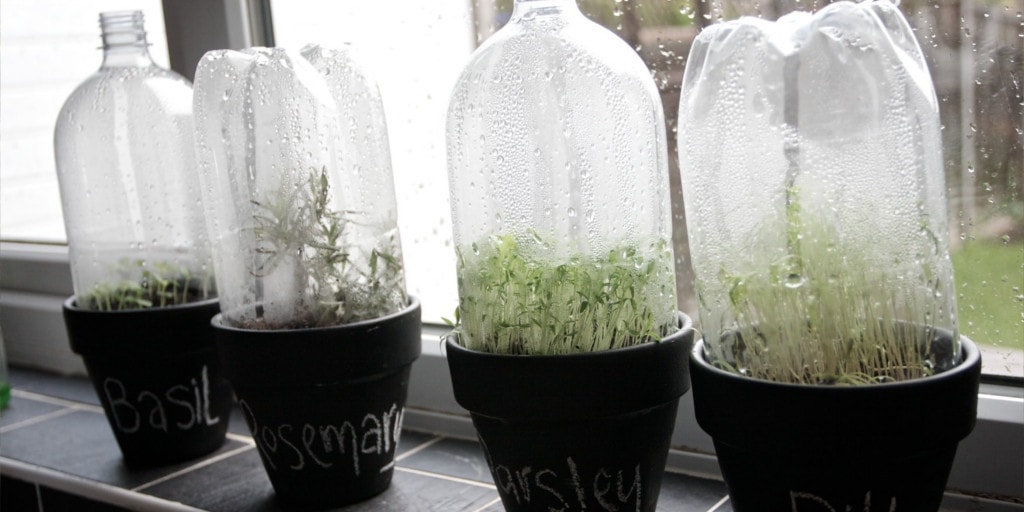Content:
Many gardeners are interested in how to care for a home rose in order to preserve the decorative effect of the bush for several years. There are a number of specific recommendations and rules, the observance of which will lead to a long and abundant flowering of all varieties of roses at home.
What you need to know before starting to grow roses at home
For a plant like a rose, home care is not too difficult. There are a huge number of varieties and types of this culture, but not all may be suitable for the home. The best option would be roses of compact and miniature size:
- A miniature rose has a height of no more than 30 cm, but there are some bush varieties no higher than 10 cm.The flowers themselves are small, double, have a pleasant aroma, or may be completely without it. The leaves are also small, solid color with a dark green matte shade. Flowering continues from early spring to late autumn. For home it is best to choose Colibri, Gold Symphonie, Maidy varieties.
- The tea rosette reaches a height of 50 cm, can bloom until winter, has a fragrant aroma and flowers of various shades. Roses of varieties Marshal Niel, Nifetos are good for growing in indoor conditions.
- Bengal roses are recognized as the best option for growing at home. They bloom magnificently all year round, the height of the bushes does not exceed 50 cm, the flowers are small in size with a terry covering, a fragrant aroma and can be red, white or pink. The best varieties include Termoza, Madame Neumann, Armoza.
- An equally interesting option is a polyanthus rose, capable of forming a large number of shoots suitable in height for growing on a window. It blooms for a long time, and the bushes themselves are strewn with inflorescences of shades of cream, pink, carmine. You can choose from such varieties as Miniatures, Triumph, Gloria, Clotilde, etc.
- Patio - a separate group was singled out only at the end of the 20th century, this includes such varieties as Lydia, Petito, Lavender Juel, however, the most popular in Russia are the patio mix roses: Danica and Hit, which do not grow above 30 cm and have double flowers ...
- The Chinese rose is a bush in height not exceeding 15 cm, the flowers themselves are small - their diameter is about 2 cm. Popular varieties are Florida, Rose, Hamburg.
- Stone - popular varieties Echeveria graceful, Echeveria Derenberg, whose stem does not exceed 10 cm in length.
Buying a rose to grow at home
Planting your own garden is troublesome, but you can also grow it at home. To do this, it is worth giving preference to homemade roses, which are either purchased in the store, or grown in the garden, and then transferred to the house in properly prepared pots.
Experts recommend making a purchase only in a specialized flower shop, where all conditions are created for the storage and development of plants. What you need to pay attention to when purchasing:
- The stem should be strong, green, smooth, without damaging the bark.
- The foliage should not show signs of disease (gusts, sores, spots, etc.).
- When it comes to flowers and buds, there may be several options. For example, if not all the buds are open, then the plant has not yet wasted energy on subsequent flowering, and the chance that the flower will look gorgeous in the future is much higher. Also, the plant will have a higher immunity, this will allow it to quickly adapt to new conditions. If the flowers begin to wither, but the foliage is green and fresh, then this is a good sign, meaning that the plant has excellent immunity and "safety margin", and constant movement from one room to another did not cause stress.
- If we consider the side of aesthetics, then you need to give preference only to those flowers that you like, so that they can really please the eye throughout their life.
Often in the store you can find roses in which the pot is only 5 cm in diameter, and the culture itself is slightly smaller than the capacity. What happened to these plants? These are just miniature roses that in adulthood will not reach a height of more than 20 cm.At the same time, ordinary indoor varieties can grow up to 45 cm.
Together with the flower, land is immediately acquired for transplanting, but it must be special, specifically for the rose, since the nutritional value of ordinary peat soil is not enough for it. The most ideal option would be a mixture with humus. It is often bought separately for mixing with soil.
How to transplant a rose after purchase
When a rose is purchased, and it is not intended for a bouquet, but will be present in the house for a long time, it is carried out:
- removing flowers;
- removal of buds;
- shortening the shoots by half.
It is also advisable to cut off the foliage, this is necessary for the further normal development of the flower. If the foliage looks acceptable, then you can leave half, but only those leaves that are most dense. This will give the plant the opportunity to significantly save energy to adapt to new housing.
When buying, quite often there is not one, but several plants in the pot at once, and the question arises as to whether they need to be transplanted? At first it may seem that in this way the bush looks much better, but you do not need to hope for abundant flowering, since the bushes will interfere with each other, literally squeezing out the rest in the struggle for a place in the sun, which will lead to a decrease in the time and intensity of flowering, frequent diseases and the emergence of many blind shoots.
The most correct solution is to separate the bushes into separate pots. If the roots are strongly intertwined with each other, then they need to be divided under running water, and the old soil should be completely washed off. If damage is found on the surface of the root system of the plant, treatment is carried out using a root formation stimulator.
The rose will feel much better in a less spacious container, as this will allow her to quickly adapt to the new earthy coma. After the plant is transplanted, it is sprayed with a preparation called Epin or Zircon and the crop is sheltered to create a mini greenhouse for a while. For this, a can, a plastic bottle or just a plastic bag is used.
If the first signs of mold are found, then the plant and its soil are treated with fungicides, for which Fitosporin would be the best option.
When the plant comes to its senses a little after such stress as transplanting, adaptation to normal conditions in the house is required. This must be done carefully and gradually, then the right care will manifest itself in the form of an improvement in the appearance and the beginning of active growth of the rose.It is imperative to monitor the humidity in the room so as not to harm the culture.
It is far from uncommon when, during transplantation, it is found that some bushes have suffered more than others, but this is not a problem at all, since, despite their far from being the most attractive appearance, roses can be supported and even cured with vitamin and mineral supplements, as well as treatment with antidepressants.
How to care for a rose at home
Caring for a home rose is generally simple, but nuances should not be overlooked:
- Holes need to be made in the pot, with their help excess moisture is removed.
- A newly purchased ceramic pot is preliminarily immersed in warm water for several hours, to adapt to the conditions of keeping and drinks with moisture, which it will not "pull" from the soil after planting.
- Do not give preference to too spacious containers.
- Roses are grown only in light-colored pots, as dark ones are capable of attracting an excessive amount of UV rays.
- Fertile and loose soil is preferred.
It is better to purchase a mix primer in a store that will:
- 2 pieces of greenhouse land;
- 2 pieces of deciduous land;
- 1 part of sod land;
- 1 part sand.
The plant needs enough light, but if placed in direct sunlight, it will cause burns on the foliage, especially with frequent spraying. It is worth paying attention to a number of the following recommendations:
- Best of all, this culture will feel on the windowsill, the windows of which are facing southeast.
- It is desirable that diffused light falls on the rose, for which a special film is glued to the window as a sun protection.
- For the winter, not just artificial lighting is installed, but a lamp with a blue-red spectrum or a phytolamp.
In summer, the air temperature in the room should not be more than +22 ° С, and in winter, provided that it is placed within a glazed balcony, at least +8 ° С. The optimum humidity level is 50% or more. Since the humidity is lower in winter, it is required to perform:
- Spraying foliage, but only with preheated water.
- Rinsing foliage from above and below.
- Installing containers of water near the pot.
For a plant such as a rose, home care consists of regular watering, because when the soil dries out, the flower simply dies. Tap water is considered unsuitable. It is preliminarily cleaned of impurities that can adversely affect the development of culture, for which a filter is used, settling for a day, warming to room temperature.
As for the temperature of the water, it will depend on the season, and during periods of rest it is made cooler - up to +18 ° C. Other important nuances:
- in the summer you need to water more abundantly, every day;
- watered moderately in winter;
- water should be watered little by little so that the soil is moistened gradually;
- water in winter only with warm water;
- exclude stagnation of water in the pan.
In spring and summer, it is imperative to feed the plant, and do this every month 2 times, and immediately after watering has been carried out. In specialized stores, you can find a lot of complex fertilizers specifically for roses, in which the presence of nitrogen and potassium is required. Mullein is used as an organic fertilizer, carefully diluted in water beforehand.
Pruning is performed at the end of autumn and immediately after flowering is completed, for this it is carried out:
- Removing weak and dry twigs.
- Elimination of shoots growing inside the bush.
- Cutting one shoot from two intertwined.
- A cut above the place where the kidney is located, from which about 5 mm recede.
- Work only with clean and sharpened tools.
In spring, pruning is done only after daylight hours have reached a maximum and is at least 10 hours.
Tips and tricks from experienced florists
It is unlikely that someone will like a pot with a dried flower, since this is not only ugly, but can also cause the accumulation of negative energy, which has a detrimental effect on the entire atmosphere in the house and on the health of the family. How to keep a rose in its best shape?
It is worth paying attention to the recommendations below:
- When growing a houseplant in winter, you need to choose a place for it where there will be a large amount of light, and since natural light will not be enough, an artificial one is required, for example, formed using a fluorescent lamp.
- It is important to transplant the plant correctly, and for this it is required to choose the period of autumn, so that rooting can take place before winter and the formation of diseases, a decrease in immunity and similar consequences can be excluded.
- It is imperative to monitor the appearance of the culture, and if at least 1 spot appears, you need to promptly take measures to treat the entire flower with an inspection of the neighboring ones.
- If the room is cool, then some gardeners prefer to install a mini-greenhouse in the form of a jar, which must be periodically raised in order for the seedlings to breathe. You can put the jar not hermetically on a pallet or windowsill, but put sticks, sticks to create small crevices.
- If a home rose is transplanted from a greenhouse into a pot, then this should be done carefully: install a mini-greenhouse over the container, gradually harden the culture, leaving it in the house for a longer time. A sudden change in climate can cause stress and subsequent death of the plant.
- As a mini-greenhouse, you can use not only a jar, but also polyethylene, as well as a plastic bottle.
- It is categorically undesirable to save on a home rose. The land should be purchased in a specialized store, as it has a lighter structure, it contains nutrients and components that prevent the occurrence of diseases and pests.
Can a rose live at home and please with a year-round color and a healthy look? Maybe the advice of experts will help to cope with a number of diseases, pests, temperature changes and the consequences of them in the off-season.
